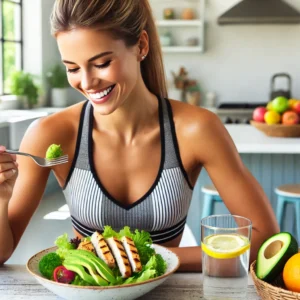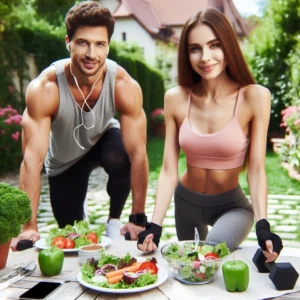Introduction
Feeling sluggish? Struggling with low energy? What if a simple, delicious salad could power you through the day? Energy-boosting salad recipes aren’t just about tossing some greens into a bowl—they’re about creating nutrient-dense meals that fuel your body and mind. These salads are designed to provide sustained energy, thanks to their combination of complex carbohydrates, healthy fats, proteins, and antioxidants.
In this guide, we’ll explore why salads can be an excellent source of energy, the best ingredients for building power-packed bowls, and three easy-to-make recipes to get you started. Whether you’re looking for post-workout recovery or midday boosts, these energy-boosting salad recipes have got you covered.
Table of Contents
Can Salads Really Boost Your Energy?
When most people think of salads, they imagine a plate of lettuce and cucumbers—not exactly energizing, right? But here’s the truth: salads can be incredibly powerful when built correctly. Let’s break it down:
How Do Salads Provide Energy?
Salads deliver energy through a balanced mix of macronutrients:
- Carbohydrates : Found in quinoa, sweet potatoes, and chickpeas, carbs give you quick energy.
- Proteins : Essential for muscle repair and sustained energy, proteins like chicken, tofu, and eggs keep you full longer.
- Fats : Healthy fats from avocados, nuts, and seeds support brain function and satiety.
- Vitamins & Minerals : Leafy greens, berries, and other superfoods pack essential nutrients that combat fatigue.
Are Salads Good for Energy?
Absolutely! The myth that salads are “just lettuce” couldn’t be further from the truth. When loaded with nutrient-rich ingredients, salads become powerhouse meals that nourish your body and boost your energy levels.
How Much Energy Is in a Salad?
The energy content depends on portion size and ingredient balance. For instance, adding quinoa or lentils increases calorie density while providing lasting energy. Always aim for a well-rounded mix of carbs, proteins, and fats.
Can I Survive on Only Salads?
While salads are nutritious, relying solely on them isn’t sustainable. Balance is key—pair salads with other whole foods to ensure you meet all your nutritional needs.
Does Salad Make You Hungrier?
Not necessarily. Fiber-rich salads filled with leafy greens, vegetables, and healthy fats can actually keep you fuller for longer. If you feel hungry after eating a salad, try adding more protein or healthy fats.
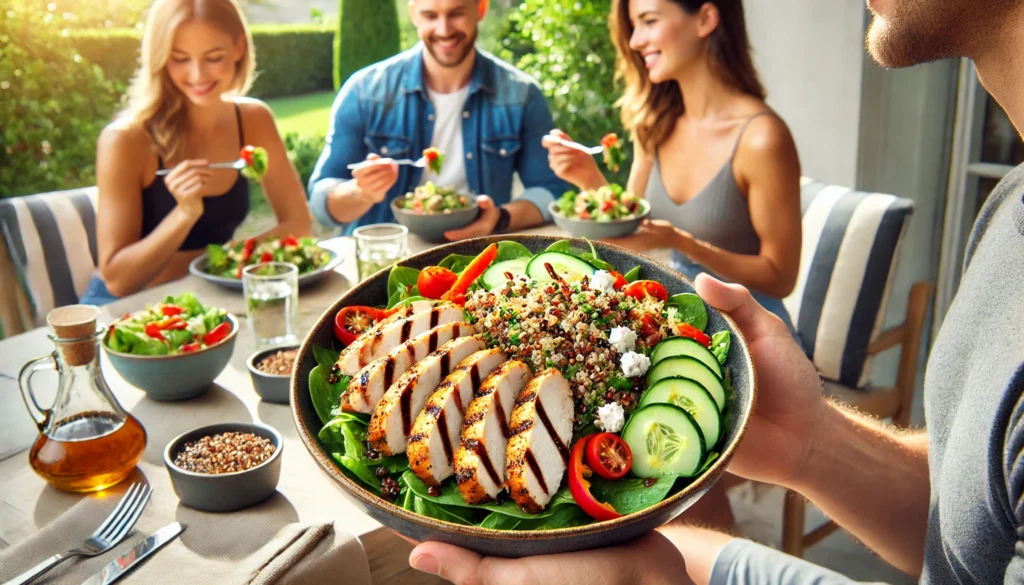
The Best Ingredients for Energy-Boosting Salads
Building an energy-boosting salad starts with choosing the right ingredients. Here’s what you need:
Leafy Greens
- Spinach: Rich in iron and magnesium, which help convert food into energy.
- Kale: Packed with vitamins A, C, and K, plus antioxidants.
- Arugula: Adds a peppery kick and contains nitrate, which improves circulation.
Complex Carbohydrates
- Quinoa: A complete protein with slow-releasing carbs.
- Chickpeas: High in fiber and plant-based protein.
- Sweet Potatoes: Provide natural sugars for steady energy.
Healthy Fats
- Avocado: Loaded with monounsaturated fats and potassium.
- Nuts & Seeds: Almonds, walnuts, chia seeds, and flaxseeds offer omega-3 fatty acids.
- Olive Oil: Anti-inflammatory properties and heart-healthy benefits.
Proteins
- Chicken: Lean and versatile, perfect for boosting energy.
- Tofu: Ideal for vegans, rich in amino acids.
- Eggs: Nature’s multivitamin, packed with protein and healthy fats.
- Beans: Lentils, black beans, and kidney beans add texture and nutrition.
Antioxidant-Rich Foods
- Berries: Blueberries, strawberries, and raspberries fight inflammation.
- Beets: Improve blood flow and reduce fatigue.
- Red Cabbage: Contains anthocyanins, which enhance energy production.
Flavor Enhancers
- Lemon Juice: Brightens flavors and aids digestion.
- Fresh Ginger: Stimulates metabolism and reduces nausea.
- Tahini: Creamy and nutty, adds richness without heaviness.
- Honey: Natural sweetness with antibacterial properties.
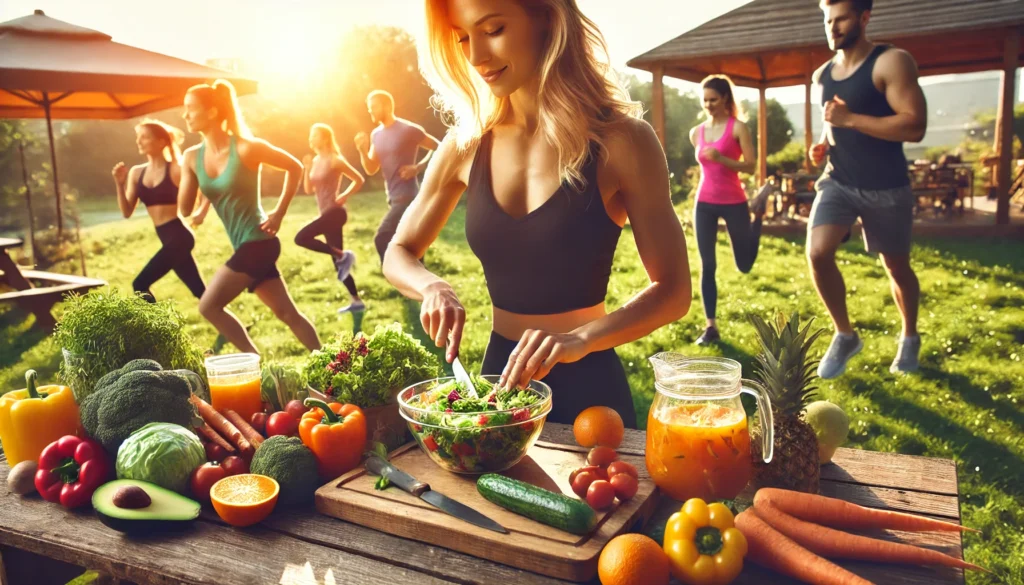
How to Build a High-Protein, Energy-Boosting Salad
Creating high-protein salads is simpler than you think. Follow this template:
- Base : Start with a bed of spinach or kale.
- Protein : Add grilled chicken, chickpeas, or tofu.
- Healthy Fats : Top with avocado slices and sprinkle with walnuts.
- Antioxidants : Include red bell peppers and blueberries for color and nutrition.
- Dressing : Drizzle with olive oil and lemon juice for a zesty finish.
3 Easy & Delicious Energy-Boosting Salad Recipes
1. Power Greens & Quinoa Salad (Post-Workout Recovery)
Ingredients :
- Baby spinach
- Cooked quinoa
- Grilled chicken breast
- Cherry tomatoes
- Cucumber slices
- Feta cheese
- Lemon vinaigrette
Instructions : Combine all ingredients in a large bowl. Dress with freshly squeezed lemon juice, olive oil, salt, and pepper.
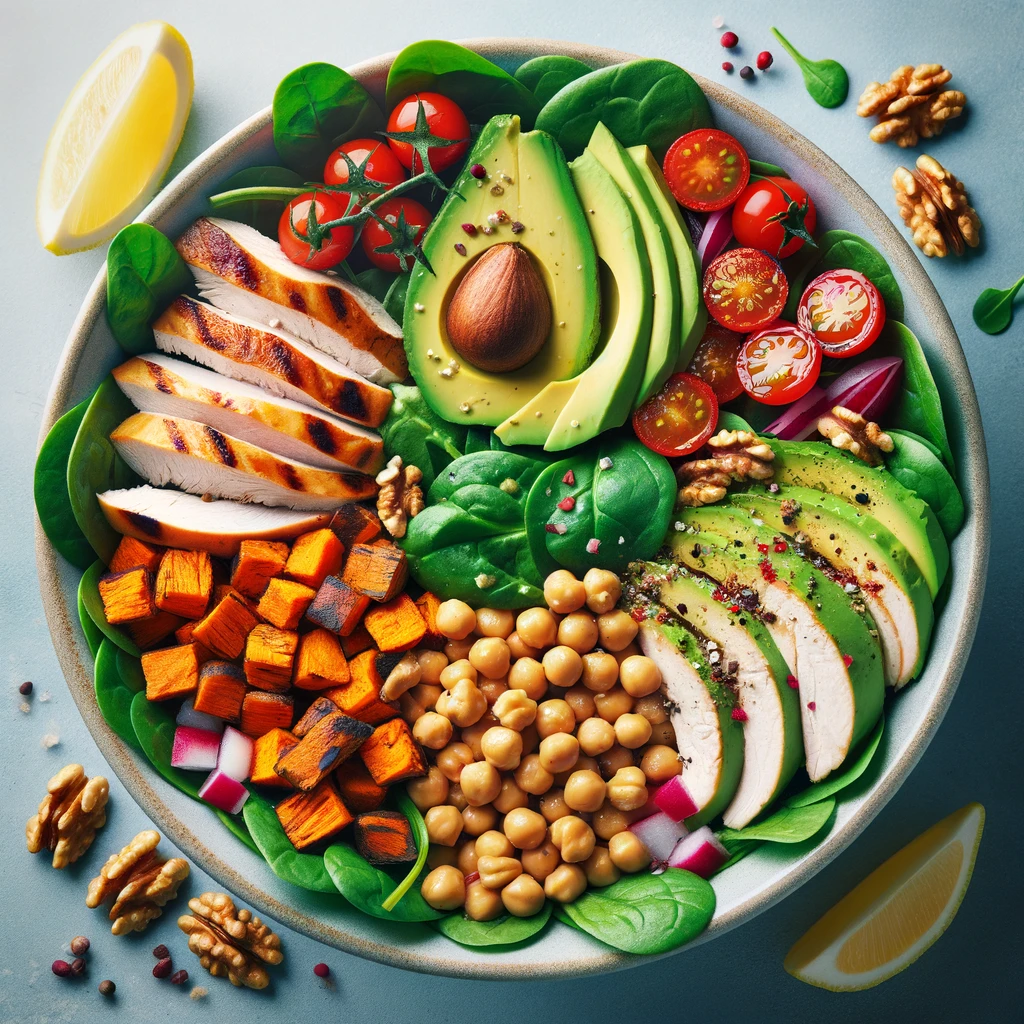
2. Avocado & Chickpea Protein Bowl (Long-Lasting Energy)
Ingredients :
- Mixed greens
- Canned chickpeas
- Diced avocado
- Roasted sweet potato cubes
- Red onion
- Tahini dressing
Instructions : Toss greens with chickpeas, avocado, and sweet potatoes. Drizzle with tahini dressing and garnish with toasted sesame seeds.
3. Mediterranean Superfood Salad (Midday Boost)
Ingredients :
- Romaine lettuce
- Cherry tomatoes
- Cucumbers
- Bell peppers
- Kalamata olives
- Feta cheese
- Grilled chicken
- Balsamic glaze
Instructions : Mix all ingredients in a bowl. Serve with balsamic glaze on top.
The Role of Antioxidants in Fighting Fatigue
Antioxidants play a crucial role in combating oxidative stress, which can lead to fatigue. By incorporating antioxidant-rich foods into your salads, you’ll experience improved energy levels and overall health.
Best Antioxidant-Rich Salad Ingredients:
- Red cabbage
- Carrots
- Berries
- Sweet potatoes
Simple Ways to Incorporate More Antioxidants:
- Add roasted beets for a pop of color.
- Sprinkle goji berries for extra crunch.
- Use turmeric in your dressings for anti-inflammatory benefits.
Raw vs. Cooked Vegetables: Which Is Better for Energy?
Both raw and cooked vegetables have their advantages. Raw veggies retain more nutrients, but cooking enhances digestibility and bioavailability of certain compounds.
Pros of Raw Vegetables:
- Retain vitamins and enzymes.
- Crisp texture adds variety.
Cons of Raw Vegetables:
- Harder to digest for some people.
- May cause bloating in sensitive individuals.
Pros of Cooked Vegetables:
- Easier to digest.
- Release more nutrients like beta-carotene.
Balancing Raw and Cooked Ingredients:
Mix both types to maximize nutrition. For example, pair raw spinach with roasted sweet potatoes for a balanced meal.
Healthy Homemade Dressings for Energy-Boosting Salads
Store-bought dressings often contain added sugars and unhealthy oils, which can drain your energy. Opt for homemade alternatives instead.
5 Simple Homemade Dressing Recipes:
- Lemon Ginger Dressing : Mix lemon juice, grated ginger, honey, and olive oil.
- Honey Mustard Vinaigrette : Whisk together mustard, honey, apple cider vinegar, and olive oil.
- Creamy Avocado Dressing : Blend avocado, lime juice, garlic, and water until smooth.
- Tahini Citrus Dressing : Combine tahini, orange juice, garlic, and cayenne pepper.
- Garlic Olive Oil Dressing : Infuse olive oil with minced garlic and herbs.
Can Salads Help with Weight Loss and Muscle Building?
Yes, salads can aid in weight loss and muscle building when prepared correctly.
Is Salad Good for Weight Loss?
Absolutely! High-fiber, low-calorie salads promote feelings of fullness and prevent overeating. Pair them with lean proteins and healthy fats for optimal results.
How to Slim Down Quickly with Energy-Boosting Salads:
Focus on nutrient-dense ingredients like quinoa, kale, and chickpeas. Avoid heavy dressings and opt for lighter alternatives.
Can Salad Build Muscle?
While salads alone won’t build muscle, they can support muscle growth by providing essential nutrients. Combine salads with adequate protein intake and proper exercise.
Best Salads for Muscle Recovery and Endurance:
Include protein-rich ingredients like grilled chicken, tofu, or hard-boiled eggs. Add complex carbs like quinoa or sweet potatoes for sustained energy.
Common Salad Mistakes That Drain Your Energy
Even the healthiest salads can fall short if not prepared thoughtfully. Watch out for these common mistakes:
- Too Much Dressing : Excess sugar and fat can zap your energy.
- Lack of Protein : Without enough protein, you may feel hungry soon after eating.
- Not Enough Variety : Monotonous salads can lead to nutrient deficiencies.
- Skipping Healthy Fats : Fat helps absorb fat-soluble vitamins; don’t skimp on it.
Expert Tips for Maximizing the Energy Benefits of Salads
To make the most of your salads, follow these expert tips:
- Meal Prep Strategies : Prepare ingredients ahead of time for quick assembly during busy days.
- Best Times to Eat Salads : Enjoy salads as lunch or dinner for sustained afternoon and evening energy.
- Make Salads More Filling : Add hearty ingredients like quinoa, beans, or roasted vegetables.
- Pair with Complementary Foods : Serve salads alongside soups, wraps, or whole-grain bread for added satisfaction.
Conclusion
Salads can be an excellent source of energy when crafted with care. By focusing on a balance of macronutrients, antioxidants, and whole foods, you can create power-packed meals that fuel your body and mind. Remember, small tweaks like adding protein, healthy fats, and complex carbs can make a big difference.
Which energy-boosting salad will you try first? Let us know in the comments below! Don’t forget to share this guide with friends who might benefit from it.
FAQ questions:
1. What are the best Energy-Boosting Salad Recipes for a quick energy lift?
Energy-boosting salad recipes are packed with nutrient-dense ingredients like leafy greens, quinoa, nuts, and seeds. Try a spinach and quinoa salad with avocado, chickpeas, and a lemon-tahini dressing. These ingredients are rich in iron, magnesium, and healthy fats, which help combat fatigue and keep you energized throughout the day.
2. How can I make Energy-Boosting Salads that keep me full for hours?
To create energy-boosting salads that keep you full, focus on high-protein salads with ingredients like grilled chicken, tofu, or lentils. Add healthy fats like avocado or olive oil, and include fiber-rich veggies like broccoli or kale. These combinations stabilize blood sugar and provide long-lasting energy.
3. What are the top High-Protein Salads for post-workout recovery?
High-protein salads are perfect for post-workout recovery. Try a grilled chicken and quinoa salad with mixed greens, cherry tomatoes, and a sprinkle of pumpkin seeds. For a plant-based option, go for a chickpea and tofu salad with tahini dressing. These salads help repair muscles and replenish energy stores.
4. Which Antioxidant-Rich Foods should I add to my salads for better health?
Boost your salads with antioxidant-rich foods like spinach, kale, blueberries, walnuts, and bell peppers. These ingredients fight oxidative stress, reduce inflammation, and support overall health. A berry and spinach salad with a balsamic vinaigrette is a delicious way to enjoy these benefits.
5. What are some easy Healthy Homemade Dressings for energy-boosting salads?
Healthy homemade dressings can elevate your salads without added sugars or preservatives. Try a lemon-tahini dressing (tahini, lemon juice, garlic, and water) or a honey-mustard vinaigrette (olive oil, Dijon mustard, honey, and apple cider vinegar). These dressings are simple, flavorful, and packed with nutrients.
6. What Nutrient-Dense Ingredients should I include in my salads for maximum energy?
For maximum energy, include nutrient-dense ingredients like quinoa, kale, sweet potatoes, chickpeas, and almonds. These foods are rich in vitamins, minerals, and healthy fats that support energy production. A kale and sweet potato salad with a lemon-garlic dressing is a great example.
7. Can Energy-Boosting Salads help with weight loss?
Yes! Energy-boosting salads can aid weight loss when made with the right ingredients. Focus on high-fiber veggies, lean proteins, and healthy fats to keep you full and satisfied. Avoid heavy dressings and opt for lighter options like a citrus vinaigrette or Greek yogurt-based dressing.
8. What are the best Energy-Boosting Salad Recipes for vegans?
Vegan energy-boosting salads can be just as powerful! Try a quinoa and black bean salad with avocado, corn, and a lime-cilantro dressing. Another great option is a kale and roasted chickpea salad with tahini dressing. These recipes are rich in plant-based protein and healthy fats.
9. How do I make a salad with Antioxidant-Rich Foods and Healthy Homemade Dressings?
Combine antioxidant-rich foods like spinach, blueberries, walnuts, and red onions with a healthy homemade dressing like a pomegranate vinaigrette (pomegranate juice, olive oil, and Dijon mustard). This combination not only tastes great but also supports your immune system and energy levels.
10. What are the most Nutrient-Dense Ingredients for a High-Protein Salad?
The most nutrient-dense ingredients for a high-protein salad include quinoa, lentils, chickpeas, grilled chicken, and hard-boiled eggs. Add veggies like spinach, broccoli, and bell peppers for extra vitamins and minerals. Top it off with a Greek yogurt-based dressing for a creamy, protein-packed finish.
11. what to eat with a salad to feel full
Pair your salad with protein-rich foods like grilled chicken or tofu, add healthy fats such as avocado or nuts, and include complex carbs like quinoa or roasted sweet potatoes for lasting fullness. Boost satisfaction with legumes, cheese, or eggs, and finish with a flavorful homemade dressing. This balanced approach ensures a satisfying, energizing meal.
12. Will a salad keep me full?
“Some salads might leave you feeling fatigued or hungry because they are lower in calories with fruits and vegetables alone,” says Kolesa. She recommends adding protein and healthy fats to make it a balanced meal that will keep you full.
13. Why do I not feel full after eating a salad?
Salads are naturally low in calories or kilojoules due to their high water content from vegetables, which can leave you feeling unsatisfied and less full until your next meal. Additionally, if your salad is heavy on carbohydrates like croutons or sweet dressings, it may cause a rapid spike and drop in blood sugar levels, increasing hunger soon after eating. On a psychological level, the act of eating a salad might also influence your mindset, potentially affecting how fulfilling you perceive the meal to be.
14. why do i feel better after eating salad?
Eating salad can make you feel better because it’s rich in fiber, vitamins, and antioxidants, promoting digestion, reducing cholesterol, and boosting energy levels. Additionally, research shows a strong link between consuming salads (especially those with fruits and veggies) and improved mood, as these foods increase serotonin production, enhancing happiness and mental well-being. Plus, the hydrating properties of vegetables help combat fatigue and improve overall health.
you may also like:
Mediterranean Salad Recipes: A Fresh Path to Health, Flavor, and Joy
Salad Recipes for Weight Loss: The Ultimate Guide to Healthy Eating and Wellness
Unlock the Benefits of Salad: Nutritional Power for Health, Wellness, and Active Living
High Protein Salad Recipes: The Perfect Fit for Health and Active Lifestyles
More relevant articles here >>>
More Health and Wellness Salad Recipes >>>
More Energy and Active Lifestyle Salad Recipes >>>
More Cultural and Seasonal Recipes >>>
References:
Health Benefits of Fruits and Vegetables


